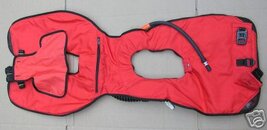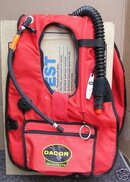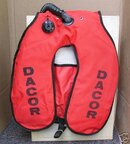Well... The idea of mounting floats to create buoyancy comes with lots of issues. What happens when the mounting breaks loose, floats colapse or get crushed, or otherwise escape their mounting? What about entanglement hazzards and additional drag from things hanging off the tanks? I can see lots of wasted time attempting to design a mounting system, getting the correct amount of buoyancy, tuning the trim, etc. All for what? To me the original problem is manageable and does not neccesitate resorting to this type of extraordinary measure.
First let's assure ourselves that this is not a solution in search of a problem. How would you dive a set of double Farber 100s? That's about 15 lbs negative empty and 30 lbs negative full. How about a set of Heiser 120s at 36 lbs empty and 53 lbs full? Or to carry it to it's logical absurdity, Heiser makes 4400 psi 190s that are about the size of OMS 135s but that as a set weight in at about 84 lbs of negative buoyancy empty and 125 lbs of negative buoyancy full. Being a scientist I like to work from the edge of the envelope in ... so how on earth am I going to dive a set of twin 190s? Granted, the only use I've ever seen such tanks put to is in the buoyancy system of a small submersible.
I'll follow my basic rules, each item needs to be neutral on it's own, so I put on my dry suit, get it comfortably inflated and weight myself. That's the lead I'll wear. I'm a big guy so let's call that 26 lbs.
At the end of my 10 foot stop I'd need about 86 lbs of positive buoyancy to offset the tanks, even if I were willing to forgo my weightbelt (and I'm not) that would still require 60 lbs of lift. The best way to get 84 lbs of lift would be two cubic feet of syntactic foam, molded between and above the cylinders, which is no big deal and looks kinda cool. You could also accomplish this with a two foot length of 3" Class T ABS (when we've used ABS for flotation we install a Schrader valve and pressurize to 150 PSI) mounted on top of the cylinders. For lesser flotation we've used spherical net floats.
If I actually had to dive tanks like that I'd install 84 lbs of flotation, use a 60 lb wing to compensate for my gas and likely wear my Fenzy just for good measure.
As to the mounting breaking loose, floats collapsing or get crushed, or otherwise escaping their mounting, or entanglement hazards and additional drag, well I'll forgive you for the insult, you do not understand what those of us who deal with stability and trim on deep submersibles do, any single such error is at the very best a $30K loss and at worst a fatality with a multi-million dollar loss. All I can say is you just have to trust us, that's a big part of what we do for a living.
The idea of someone showing up to a trimix check out dive wearing a bright orange Fenzy for redundant bouyancy made me chuckle. (FWIW - I never really liked the way they fit, but they sure can provide some lift, and are about 10 times tougher than any bladder I have ever seen. )
Acutally I have three, one is for parts, one is bright orange and one is in Marine Nationale black. For timix I'd have to wear black, its way to gauche to wear orange, especially after Labor Day.
hen I started thinking about my NOS USD horse collar. It has the stab type inflator hose plugs in towards the bottom of the BCD on the right hand side. The inflator is also rigged with a lever that can pull dump valve by the shoulder. The oral inflator is on the left. It is a small corrugated hose that stays flush against the BCD with velcro.
That's a BC II also known as a BC-707, perhaps the best conventional horse collar made. I hope you have the black model, the yellow is a bit gaudy.
Of course, I want to dive a Dacor Nautilus to see how it works, so my judgement is probably a little questionable.
Trust me, you don't it's like trying to swim a 4x8 piece of plywood through the water the hard way.
Note: Dacor tried to market a horse collar/wing combo many years ago. It was called the Sea Chute. Basically it was 2 bladders; a horse collar and a wing combined in one shell.
Never tried it, it looked interesting and then my DSO told that if I used it I was 'gonna die.







